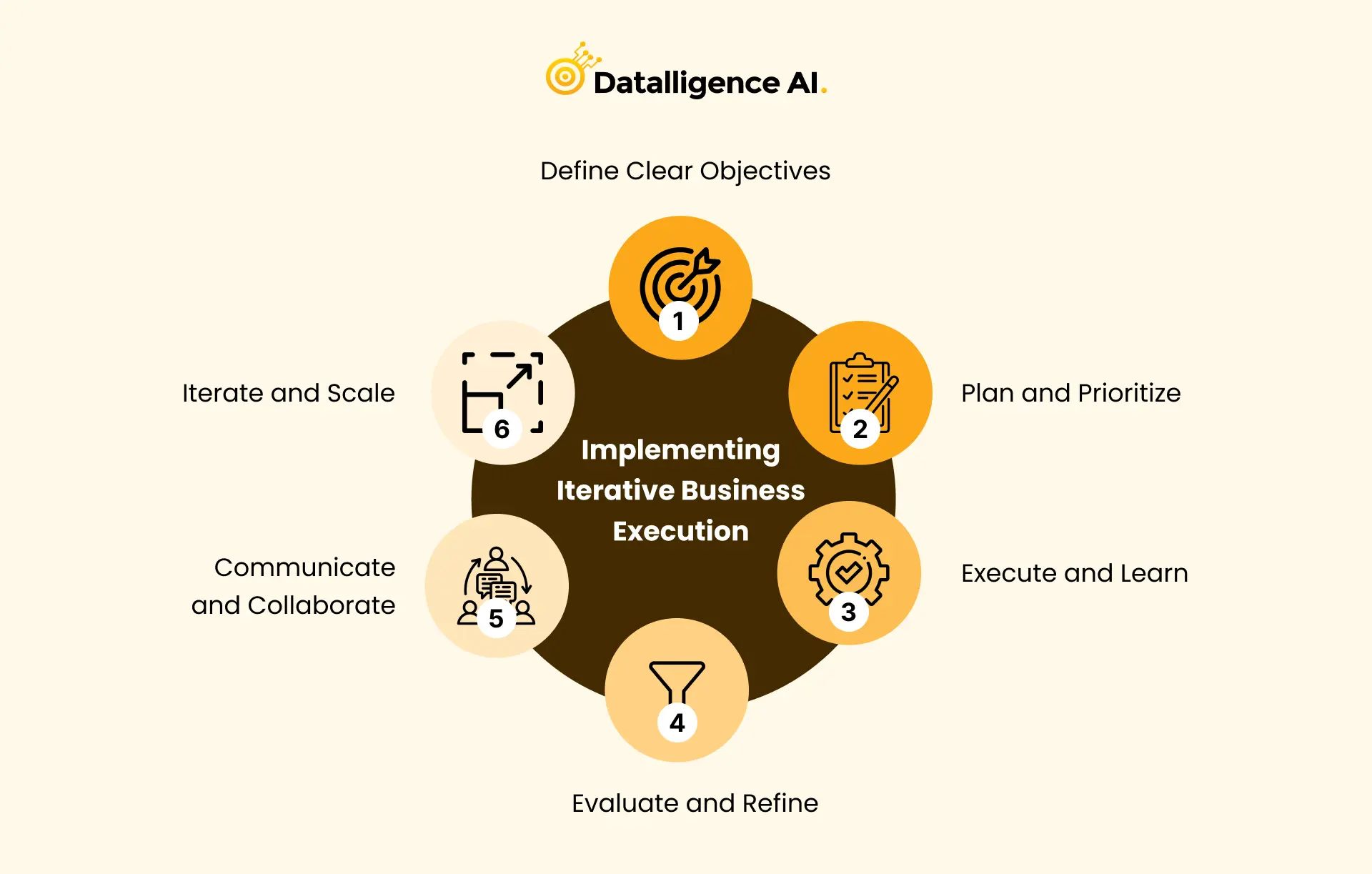In today’s dynamic business landscape, organizations face the constant challenge of adapting to changing market conditions and customer demands. To thrive in such an environment, businesses need a flexible and effective approach to executing their strategies and initiatives. This is where iterative business execution comes into play.
Iterative business execution is a methodical and continuous process of refining and improving business strategies, projects, and products through a series of iterations. It allows organizations to make incremental changes, gather feedback, and adjust their approach based on real-world results. In this comprehensive guide, we will delve into the concept of iterative business execution, explore its benefits, and provide a step-by-step process to implement it successfully.
Table of Contents
What is iteration in business?
In the context of business, iteration refers to the repetition of a process or set of steps with the goal of improvement and refinement. It involves systematically reviewing, testing, and revising elements of a project or initiative to enhance its effectiveness. Iteration is a fundamental principle in various fields, including software development, product design, and project management.
In iterative business execution, organizations embrace a cyclical approach to achieve continuous improvement. Instead of following a linear path, where each step is completed once, iterative business execution involves repeating the process multiple times to refine and enhance the desired outcomes. This iterative approach allows organizations to respond to feedback, adapt to changing circumstances, and optimize their strategies for success.
Benefits of Iterative Business Execution
Implementing an iterative business execution approach offers numerous benefits for organizations. Let’s explore some of the key advantages:
- Adaptability: Iterative business execution allows organizations to adapt and respond quickly to changes in the market, customer preferences, and internal dynamics. It enables organizations to pivot their strategies, processes, and initiatives based on real-time feedback and insights.
- Continuous Improvement: By embracing an iterative approach, organizations can continuously improve their strategies, processes, and products. Each iteration provides an opportunity to learn from previous experiences and make incremental enhancements to achieve better outcomes.
- Risk Mitigation: Iterative business execution helps mitigate risks by identifying and addressing potential issues early in the process. By conducting regular evaluations and refinements, organizations can minimize the impact of potential failures or setbacks.
- Increased Collaboration: An iterative approach fosters collaboration and cross-functional teamwork. It encourages open communication, knowledge sharing, and collective problem-solving, leading to more effective decision-making and better outcomes.
- Customer-centricity: Iterative business execution enables organizations to stay closely aligned with customer needs and expectations. By incorporating customer feedback and insights into each iteration, organizations can deliver products and services that meet customer requirements effectively.
- Efficient Resource Allocation: By regularly evaluating and refining strategies and initiatives, organizations can optimize resource allocation. This ensures that resources are used effectively, minimizing waste and maximizing return on investment.
Implementing Iterative Business Execution

Now that we understand the benefits of iterative business execution let’s explore how to implement it effectively in your organization. The following steps outline a systematic approach to adopting iterative business execution:
Step 1: Define Clear Objectives
Start by clearly defining your objectives and desired outcomes. Identify key performance indicators (KPIs) and metrics that will help you measure success at each iteration.
Step 2: Plan and Prioritize
Develop a roadmap or plan that outlines the sequence of iterations and the specific initiatives or projects to be executed. Prioritize initiatives based on their potential impact and alignment with organizational goals.
Step 3: Execute and Learn
Execute each iteration, focusing on delivering tangible outcomes within a defined timeframe. Collect data, feedback, and insights throughout the process to learn from successes and failures.
Step 4: Evaluate and Refine
Regularly evaluate the outcomes of each iteration against the defined objectives and metrics. Identify areas for improvement and refine strategies, processes, and initiatives based on the insights gained.
Step 5: Communicate and Collaborate
Ensure effective communication and collaboration across teams and stakeholders. Share learnings, discuss challenges, and gather input from diverse perspectives to drive continuous improvement.
Step 6: Iterate and Scale
Repeat the process, incorporating the learnings from each iteration into subsequent cycles. As you gain confidence and refine your approach, scale up the implementation of iterative business execution across the organization.
Case Study: Implementing Iterative Business Execution at XYZ Company
XYZ Company, a leading technology firm, successfully implemented iterative business execution to drive innovation and improve product development processes. By embracing an iterative approach, XYZ Company achieved the following outcomes:
- Faster Time-to-Market: Iterative business execution allowed XYZ Company to bring new products to market faster by enabling rapid prototyping, testing, and refinement.
- Enhanced Customer Satisfaction: By incorporating customer feedback into each iteration, XYZ Company delivered products that better met customer needs and expectations, leading to increased customer satisfaction and loyalty.
- Improved Resource Allocation: Through regular evaluations and refinements, XYZ Company optimized resource allocation, ensuring that resources were effectively utilized and focused on high-impact initiatives.
- Increased Innovation: The iterative approach fostered a culture of innovation within XYZ Company, encouraging employees to experiment, take risks, and learn from failures. This resulted in a steady stream of new ideas and improved product offerings.
Conclusion: Unlocking Success Through Iterative Business Execution
Organizations must embrace a flexible and adaptive approach to drive success in today’s rapidly evolving business landscape. Iterative business execution offers a powerful methodology to continuously improve strategies, processes, and initiatives. By implementing an iterative approach, organizations can achieve adaptability, continuous improvement, risk mitigation, increased collaboration, customer-centricity, and efficient resource allocation. Whether you are a startup or an established enterprise, embracing iterative business execution can unlock new opportunities and drive sustainable growth in your organization.
At Datalligence.AI, we understand the power of iterative business execution. Our AI-powered solutions can help you streamline your iterative processes, optimize resource allocation, and drive data-driven decision-making. Contact us today to learn more about how our solutions can transform your business.










